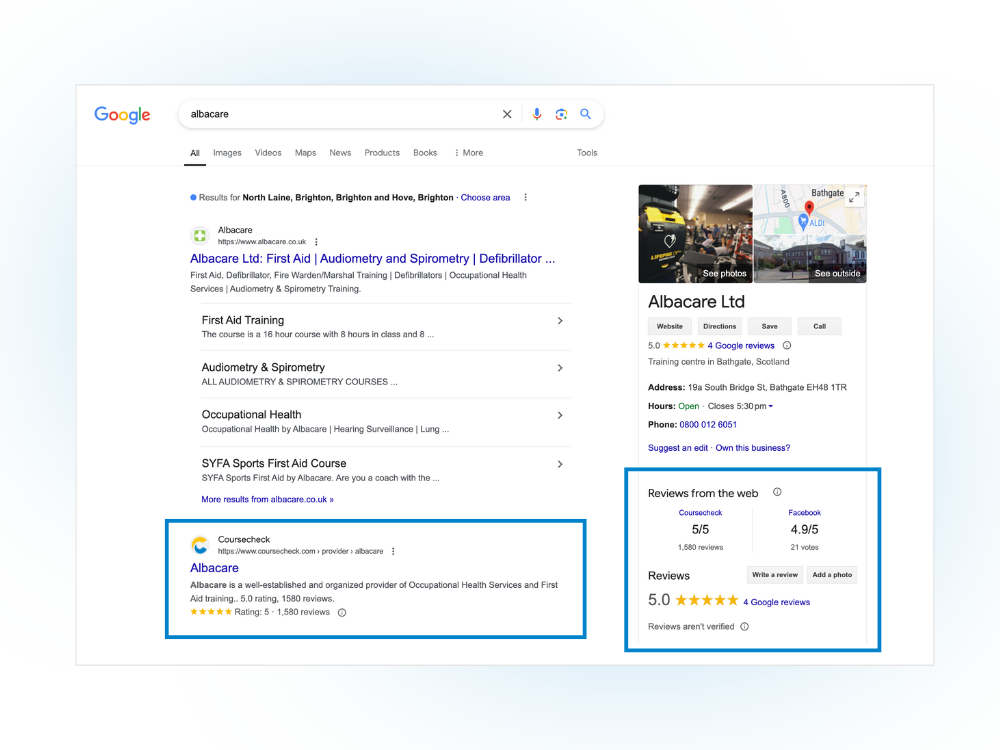
Marketing your training courses effectively is essential for reaching a wider audience and boosting registrations. Customer reviews are increasingly important when it comes to promoting your training because they provide authentic, firsthand feedback that builds trust and credibility. Not only do they serve as a powerful form of social proof that can influence purchasing decisions, but online reviews significantly boost your website’s visibility in online search. In this guide, we’ll explore some key strategies to effectively use customer reviews to promote your courses, increase engagement, and drive conversions.
Why reviews matter
- Authenticity: User-generated content, such as reviews, is seen as one of the most genuine forms of marketing. It provides an authentic reflection of what your courses offer, helping to establish credibility.
- Trust: Independent reviews carry more weight than handpicked testimonials. Seeing unfiltered feedback from real learners builds trust in your brand.
- Emotional connection: People often rely on the actions and opinions of others when making decisions. Independent reviews help create an emotional connection with your brand and reinforce reliability.
- Conversions: In a world where 95% of consumers read online reviews before making a purchase, customer feedback is essential for bringing new business through the door.
Six steps to use your customer reviews to sell your training
Step 1: Build a standout profile on a review platform
Your online presence acts as a digital shopfront for your courses. Third-party review platforms like Coursecheck help you to showcase your customer feedback and build a strong online reputation. Whichever platform you choose, make sure you have a standout profile that is complete, professional, and engaging.
Key elements of a great online profile:
- Engaging images: Use high-quality images that reflect your brand and attract attention.
- Company overview: Give prospective learners a snapshot of your company, its values, and what makes your courses unique.
- Clear course descriptions: Choose a platform that allows you to provide detailed information about each of your courses alongside specific reviews relating to each course.
- Multimedia: If possible, include a short explainer video to give a quick overview of your courses.
- Contact information: Make it easy for prospective learners to get in touch or book a course.

Why Coursecheck?
Purpose-built for training providers, Coursecheck makes it easy to collect, manage, and showcase verified learner feedback. Unlike generic review platforms, Coursecheck links every review to a specific course, giving prospects the detail and trust they need to book with confidence.
Key benefits:
- Automated review collection at the end of each course
- Course-specific feedback to build trust and improve conversions
- SEO-optimised widgets to boost your visibility online
- Verified reviews that add instant credibility
“Coursecheck provides us with a clean and easy way of monitoring our student satisfaction, and it's a confidence-booster for new students who are looking to book with us.”
— Abby Fermont, Proactive Technical Training
Coursecheck isn't just about reviews—it's about helping your training business grow.
Step 2: Respond to feedback thoughtfully
How you respond to reviews is just as important as the reviews themselves. It demonstrates that you value your learners’ opinions and are committed to continuous improvement.
In Coursecheck, there is the option to reply publicly or privately to feedback comments. Of course, it’s not a substitute for picking up the phone and resolving issues directly, if needs be, but it’s a good opportunity to show prospective customers your approach to customer care.
Negative feedback is an inextricable part of customer service. It’s also a great opportunity to learn more about your business and how you can improve your services. Whilst it isn’t necessary to respond to every single comment, if someone has taken the trouble to provide thoughtful feedback (good or bad), it’s good practice to acknowledge it. And by responding publicly to negative feedback, it gives you the chance to show others what kind of company you really are.
Tips for responding to feedback:
- Respond promptly. If you’re going to respond to a comment (good or bad), try to do it within 24 hours.
- Learn from constructive feedback. If someone makes a fair negative comment, identify it as an area for improvement. Respond positively and highlight your commitment to progress.
- Think about the wider audience. Not every review will be fair. If someone makes an unreasonable comment, empathise without apologising. Reply with a brief response saying you’ll follow up directly to discuss the issue.
Negative feedback in itself isn’t as damaging as the way you respond to it could be. Here’s an example of how to respond publicly to negative feedback that you deem unreasonable.
“Thank you for sharing your thoughts with us. We understand that everyone’s experience can be different, and we’d like the opportunity to better understand your perspective. We’ll reach out to you directly to discuss this further.”

Pro Tip: Learn how to encourage detailed, helpful comments in our guide How to get high quality customer feedback.
Step 3: Showcase reviews on your website
Displaying reviews on your website is a great way to build trust and encourage potential learners to take action. Some review platforms allow you to use a widget to display a carousel of reviews on your homepage, as well as your course pages. From your prospective customers point of view, it's much more useful if you can show them reviews about the specific course that they're thinking of booking. Not all review platforms allow this more granular approach so it's worth checking.
Benefits of integrating reviews with your website:
- Increased credibility: Showcasing live reviews demonstrates transparency and builds trust with prospective learners.
- SEO advantages: Regularly updating your website with fresh content, like new reviews, will improve your rankings in search engines, making it easier for people to discover your courses (more about this below).
- Enhanced user engagement: Course-specific review widgets help potential learners by providing feedback that’s relevant to the specific course they’re interested in.
If you're using a platform like Coursecheck, it’s easy to integrate review widgets on your site, whether using WordPress or another content management system.

Step 4: Use reviews for Search Engine Optimisation (SEO)
Customer reviews are an essential tool for SEO. Integrating your reviews with your website will refresh content regularly, boosting your Google ranking and driving more organic traffic. Star ratings in Google search results will help to attract attention to your course pages.
SEO Best Practices:
- Regular updates: Frequently adding fresh content, such as reviews or blog posts, shows search engines that your site is active and relevant.
- Use relevant keywords: If customers are frequently using specific keywords when describing their experience, such as “data science certification” or “online leadership training”, make sure you incorporate those phrases into your course descriptions.
- Use schema markup: Implementing review schema markup on your website allows Google to display star ratings in search results, which can increase your click-through rate (CTR).
- Google Business Profile: If you haven’t already, create a Google Business Profile. This can improve your local SEO and help ensure your reviews appear in Google searches, boosting visibility.

Step 5: Harness the power of social media
Social media is one of the most effective tools to spread the word about your training courses, where people expect authentic, engaging content. It allows you to reach a broad audience and create a community around your brand.
Social media marketing tips:
- Highlight reviews: Share positive reviews across all your social platforms. Use bold, eye-catching visuals and minimal text to focus attention on the review.
- Promote user-generated content: Encourage past learners to share their experiences online and tag your company. This kind of content is seen as more authentic and can influence new learners.
- Engage with followers: Interact with your audience by responding to comments and sharing relevant content.

Step 6: Incorporate reviews into your marketing materials
However you communicate with existing and prospective customers, feedback is something worth talking about. You can refer to your latest ratings, accentuate your best customer comments, and use it as a catalyst to talk about the quality of training more generally. Incorporate customer reviews into brochures, emails, flyers, and sales presentations.
Never miss an opportunity to shout about your reviews:
- Email communications: Include a widget displaying your average course rating in the footer of your emails, with a link to read your reviews.
- Course flyers: Include a section featuring top reviews or course ratings in your printed or digital brochures.
- Sales presentations: Highlight strong reviews and your average course rating during client meetings or presentations, to increase trust and credibility.

Final thoughts
Marketing your training courses is all about building credibility and making it easy for potential learners to find and engage with your courses. By leveraging reviews and optimising your online presence, you’ll create an authentic and effective feedback system that improves your offering and builds trust with prospective customers.
If you use a platform like Coursecheck, you can take full advantage of tools that allow you to build your profile, collect and analyse feedback, and display reviews in real-time.
To find out more, book a demo, or start your free trial.
